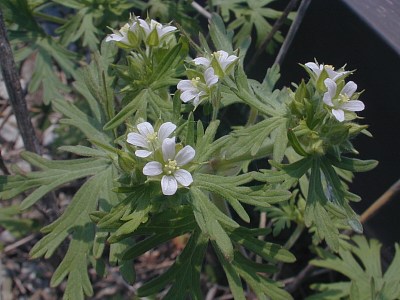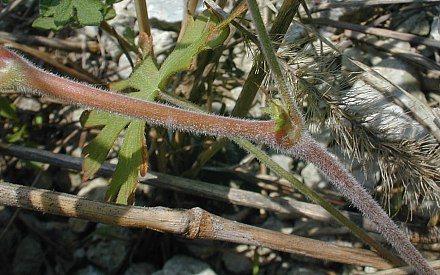Description: This plant is a summer annual about 1' tall that branches occasionally at its base and along its stems. Sometimes the lower stems sprawl along the ground. These stems are round and covered with white hairs; they often become reddish brown as they mature. The opposite leaves are about 3" long and across. These leaves are palmate, having 3-9 primary lobes, while their margins have coarse, but widely spaced teeth, or additional secondary lobes. The leaves often have a greyish green appearance because of a fine pubescence. The petioles are usually long and hairy. The flowers occur on very short pedicels in tight clusters; they are up to 1/3" (8 mm.) across. The flowers have 5 petals that are dull white to light pink, and 5 dull green sepals that are lanceolate with elongated tips. The sepals are nearly as long as the petals. The blooming period occurs from early to mid-summer, lasting about a month. There is no noticeable floral scent. The seeds develop within a long narrow beak about 1" long, hence the common name of this plant. Eventually this beak splits open and flings the seeds. The surface of the seeds is finely reticulated. The root system consists of a taproot.

Cultivation:
The
preference is full or partial sun, and dry conditions. The Carolina
Cranesbill prefers poor soil that is gravelly, sandy, or contains
hardpan clay, as this reduces competition from other plants. It
develops rapidly from seed and may reseed itself aggressively in
sterile areas with little vegetation. Soil with a high pH is tolerated.
Range & Habitat:
The Carolina Cranesbill occurs frequently in the southern half of
Illinois, and occasionally elsewhere within the state (see Distribution
Map). Habitats include rather dry open woodland areas, upland
areas of clay prairies, gravel prairies, limestone glades, pastures and
abandoned fields, lawns and roadsides, and miscellaneous waste areas.
This species responds positively to occasional fires.
Faunal Associations:
The flowers are visited occasionally by long-tongued bees (Megachile
spp.), short-tongued bees (Halictid), and flower flies
(Syrphid); these insects seek nectar primarily. The seeds are eaten by
the
Mourning Dove.

Photographic
Location:
The photographs were taken in a gravelly waste area of Judge Webber
Park in Urbana, Illinois.
Comments:
The Carolina Cranesbill is smaller and less showy than the native
woodland species, Geranium maculatum (Wild
Geranium). It is similar in appearance to several other annual Geranium
spp. from Europe, all of them rather weedy plants. One
distinctive characteristic of the Carolina Cranesbill is the shortness
of the pedicels (flowering stalks), which are less than half as long as
the sepals of the flowers. Thus, the flowers of this plant occur in
rather tight clusters. The leaves are also more likely to have
secondary lobes, and they are quite large in relation to the overall
size of this plant. A similar native species, Geranium
bicknellii (Northern Cranesbill), has a more northern
distribution. This plant has deep pink flowers, and the beak-shaped
fruit has a longer awn at its apex than the corresponding fruit of the
Carolina Cranesbill.